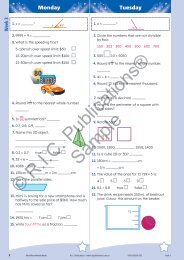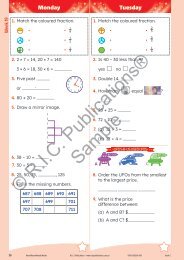PR-0552UK Primary Science - Book 2
Create successful ePaper yourself
Turn your PDF publications into a flip-book with our unique Google optimized e-Paper software.
Choosing materials<br />
Properties and characteristics of materials ~ Activity 3<br />
Objective<br />
• identify and investigate<br />
materials that absorb water and<br />
those that are waterproof<br />
Working scientifically<br />
• Questioning<br />
• Observing<br />
• Predicting<br />
• Investigating and<br />
experimenting<br />
• Analysing (interpreting)<br />
• Recording and communicating<br />
Designing and making<br />
• Exploring<br />
Background information<br />
Properties of materials are those<br />
characteristics of materials that<br />
determine their suitability for specific<br />
applications.<br />
Through this unit, pupils should<br />
extend their knowledge of the<br />
range of materials we use and of the<br />
properties that characterise them.<br />
This knowledge should help<br />
them recognise what needs to<br />
be considered when a material is<br />
chosen for a particular use.<br />
Before the lesson<br />
Materials needed<br />
• Each group: about four each of 10-cm squares of paper towel, tissue, writing<br />
paper, magazine paper, newspaper, aluminium foil; a jar of water, teaspoon,<br />
soft drink bottle.<br />
Preparation<br />
• Cut out 10-cm squares of the paper towel for the absorbency test.<br />
• Prepare a wet area for the test.<br />
The lesson<br />
Stimulus<br />
• Discuss what may happen if pencils were made of glass, chairs of concrete,<br />
pillows of steel etc.<br />
• Spill some water and try to mop it up with steel wool or something<br />
inappropriate.<br />
What to do<br />
• Discuss why specific materials have been chosen to make certain objects. For<br />
example, a bath toy is often made of plastic so it will float and does not absorb<br />
water.<br />
• In groups, pupils complete Question 1 on the worksheet.<br />
• As a class, discuss the reasons given in the last column.<br />
Note: This could be one lesson finished.<br />
• Demonstrate the testing procedure to the class; i.e. one teaspoon of water to<br />
be absorbed.<br />
• Pupils complete their testing. (Each group has about four pieces of each material<br />
to test, so they can do a test run first before recording.)<br />
• Pupils complete the questions about the test.<br />
After the lesson<br />
Answers<br />
1. Possible answers<br />
• Soft drink bottle – plastic – transparent to see drink, flexible and will not break<br />
if dropped.<br />
• Window – glass and wood, nails, plastic – transparent, the light comes in, we<br />
can see in and out, hard.<br />
• Shirt – cloth and plastic buttons – light, flexible, dries quickly when washed,<br />
soft to touch (feels nice).<br />
2.– 4.<br />
Teacher check. (Pupils should come to the conclusion that good absorbent paper<br />
has open weave material and is light and dry.<br />
Viewing Sample<br />
Additional activities<br />
• Continue the activity in Question 1 with different objects.<br />
Display ideas<br />
• Set up a display of the materials and a selection of the worksheets.<br />
84 <strong>PR</strong>IMARY SCIENCE ~ Prim-Ed Publishing ~ www.prim-ed.com


















